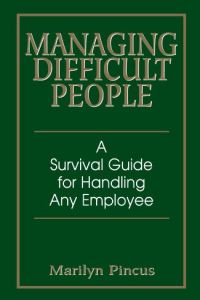Join getAbstract to access the summary!

Join getAbstract to access the summary!
Marilyn Pincus
Managing Difficult People
A Survival Guide For Handling Any Employee
Adams Media, 2004
What's inside?
The nay sayers, the bullies, the social butterflies – every office has difficult characters. Here's how to manage them.
Recommendation
You can learn how to handle problem employees three ways: figure it out for yourself, get a great mentor or read this book. Designed primarily for managers rather than human resources professionals, it's a handy guide to different problem personalities. Author Marilyn Pincus provides several alternative solutions for how to counter each type's negative influence on your organization. Her clear writing and thoughtful organization make the book even more useful. While author Pincus doesn't provide detailed advice on the legal and procedures aspects of employment, she does tell you when the ice is getting thin enough to seek the advice of professionals. getAbstract strongly prescribes her book to help bring managerial blood pressure readings back into the normal range.
Summary
About the Author
Marilyn Pincus is a management consultant in Sun Lakes, Arizona. She has written for major business publications and is a member of the International Association of Business Communicators.
















Comment on this summary